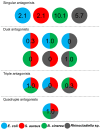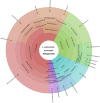Analyzing the antagonistic potential of the lichen microbiome against pathogens by bridging metagenomic with culture studies
- PMID: 26157431
- PMCID: PMC4476105
- DOI: 10.3389/fmicb.2015.00620
Analyzing the antagonistic potential of the lichen microbiome against pathogens by bridging metagenomic with culture studies
Abstract
Naturally occurring antagonists toward pathogens play an important role to avoid pathogen outbreaks in ecosystems, and they can be applied as biocontrol agents for crops. Lichens present long-living symbiotic systems continuously exposed to pathogens. To analyze the antagonistic potential in lichens, we studied the bacterial community active against model bacteria and fungi by an integrative approach combining isolate screening, omics techniques, and high resolution mass spectrometry. The highly diverse microbiome of the lung lichen [Lobaria pulmonaria (L.) Hoffm.] included an abundant antagonistic community dominated by Stenotrophomonas, Pseudomonas, and Burkholderia. While antagonists represent 24.5% of the isolates, they were identified with only 7% in the metagenome; which means that they were overrepresented in the culturable fraction. Isolates of the dominant antagonistic genus Stenotrophomonas produced spermidine as main bioactive component. Moreover, spermidine-related genes, especially for the transport, were identified in the metagenome. The majority of hits identified belonged to Alphaproteobacteria, while Stenotrophomonas-specific spermidine synthases were not present in the dataset. Evidence for plant growth promoting effects was found for lichen-associated strains of Stenotrophomonas. Linking of metagenomic and culture data was possible but showed partly contradictory results, which required a comparative assessment. However, we have shown that lichens are important reservoirs for antagonistic bacteria, which open broad possibilities for biotechnological applications.
Keywords: Stenotrophomonas; antagonistic bacteria; lichen; plant growth promotion; spermidine.
Figures





Similar articles
-
Symbiotic Interplay of Fungi, Algae, and Bacteria within the Lung Lichen Lobaria pulmonaria L. Hoffm. as Assessed by State-of-the-Art Metaproteomics.J Proteome Res. 2017 Jun 2;16(6):2160-2173. doi: 10.1021/acs.jproteome.6b00974. Epub 2017 May 4. J Proteome Res. 2017. PMID: 28290203
-
The Lichens' Microbiota, Still a Mystery?Front Microbiol. 2021 Mar 30;12:623839. doi: 10.3389/fmicb.2021.623839. eCollection 2021. Front Microbiol. 2021. PMID: 33859626 Free PMC article. Review.
-
Exploring functional contexts of symbiotic sustain within lichen-associated bacteria by comparative omics.ISME J. 2015 Feb;9(2):412-24. doi: 10.1038/ismej.2014.138. Epub 2014 Jul 29. ISME J. 2015. PMID: 25072413 Free PMC article.
-
Bacterial line of defense in Dirinaria lichen from two different ecosystems: First genomic insights of its mycobiont Dirinaria sp. GBRC AP01.Microbiol Res. 2020 Mar;233:126407. doi: 10.1016/j.micres.2019.126407. Epub 2019 Dec 28. Microbiol Res. 2020. PMID: 31945518
-
Nutrient scavenging activity and antagonistic factors of non-photobiont lichen-associated bacteria: a review.World J Microbiol Biotechnol. 2016 Apr;32(4):68. doi: 10.1007/s11274-016-2019-2. Epub 2016 Mar 1. World J Microbiol Biotechnol. 2016. PMID: 26931608 Review.
Cited by
-
Root-Associated Microbiomes of Panax notoginseng under the Combined Effect of Plant Development and Alpinia officinarum Hance Essential Oil.Molecules. 2022 Sep 15;27(18):6014. doi: 10.3390/molecules27186014. Molecules. 2022. PMID: 36144749 Free PMC article.
-
Towards a Systems Biology Approach to Understanding the Lichen Symbiosis: Opportunities and Challenges of Implementing Network Modelling.Front Microbiol. 2021 May 3;12:667864. doi: 10.3389/fmicb.2021.667864. eCollection 2021. Front Microbiol. 2021. PMID: 34012428 Free PMC article. Review.
-
Endolichenic fungi: the lesser known fungal associates of lichens.Mycology. 2017 Jul 17;8(3):189-196. doi: 10.1080/21501203.2017.1352048. eCollection 2017. Mycology. 2017. PMID: 30123639 Free PMC article.
-
Diversity and Physiological Characteristics of Antarctic Lichens-Associated Bacteria.Microorganisms. 2021 Mar 15;9(3):607. doi: 10.3390/microorganisms9030607. Microorganisms. 2021. PMID: 33804278 Free PMC article.
-
3D biofilms: in search of the polysaccharides holding together lichen symbioses.FEMS Microbiol Lett. 2020 Mar 1;367(5):fnaa023. doi: 10.1093/femsle/fnaa023. FEMS Microbiol Lett. 2020. PMID: 32037451 Free PMC article. Review.
References
Grants and funding
LinkOut - more resources
Full Text Sources
Other Literature Sources
Molecular Biology Databases

